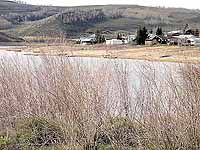| Utah anglers are encouraged to take advantage of high elevation lakes and reservoirs such as Scofield this summer. |
In order to beat the drought and enjoy good fishing all summer, head to Utah’s high country where hundreds of lakes and streams are teeming with trout.
“The water levels at most high elevation waters are much more stable than they are at lower and mid-elevations,” advised Division of Wildlife Resources fisheries coordinator, Tom Pettengill. “The water level may decrease a few feet at high elevation waters, instead of the tens of feet it may drop elsewhere.”
Pettengill classifies a high elevation water as any water at least 7,000 feet in elevation. These include large reservoirs and lakes, such as Flaming Gorge, Scofield and Fish Lake, and hundreds of smaller lakes and streams.
Many of these small lakes and streams are found on the Uinta and Boulder mountains. Several are also found on the mountains along the Wasatch Front, on the Beaver Mountains above Beaver and on the Manti-La Sal National Forest in central Utah.
Pettengill says most of these smaller lakes don’t fluctuate much because water isn’t drawn from them for irrigation and other uses. They also receive more rain and snow than waters at lower elevations and lose less water to evaporation because of cooler temperatures.
Anglers don’t need much gear to fish these small lakes and streams. A spinning rod and a bubble and a variety of lures or flies, or basic baits such as salmon eggs or worms, will work.
“The fish are usually feeding on small stuff so if anglers are using spinners, I’d recommend a size zero or one,” advised Pettingill. “If using flies, I’d recommend sizes ranging from 16 to no bigger than 10.”
One challenge to fishing these waters is reaching them.
“You can drive right up to some of them, while others may require a hike of anywhere from one to five miles,” Pettengill explained. “Consider physical limitations and be realistic about what can be done. Also, the weather in the high country can change quickly. Make sure a fleece jacket is included with the raingear in a backpack, and wear some good, waterproof boots for the hike.”
To find success, Pettengill encourages anglers to move around.
“On the Unitas and Boulders, several lakes are fairly close to each other, so if success is not found at one lake, go to another. And don’t overlook the streams, which can provide some great fishing,” recommended the fisheries expert.
During the middle of the summer, anglers should fish during the mornings and evenings, when the temperatures are the coolest and the fish are most active.
“As it gets cooler later in the summer, anglers may want to fish in the middle of the day, when the temperatures are a little warmer and there’s more insect activity,” continued Pettengill.
Many high elevation lakes get so cold in the winter that the fish in them die. To know whether a lake has fish in it, first look to see if it’s teeming with insect activity. If it is – but no fish activity is witnessed-all of its fish were probably lost during the winter.
“Also, if an angler comes to a lake and don’t see any fish activity, don’t give up on it,” he advised. “Move to another lake to fish but visit that lake again, later in the day. Timing might have been off a little and it might be teeming with insect and fish activity the second time.”
Pettengill advised that U.S. Forest Service offices are some of the best places to find maps for high elevation lakes and streams in Utah.
The DWR has also published a series of booklets and may be purchased at most division offices.

